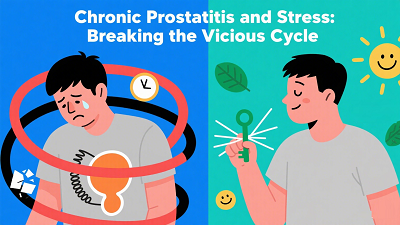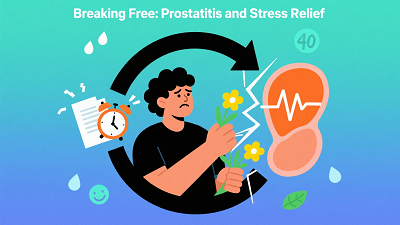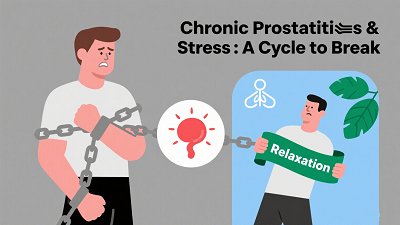Chronic Prostatitis and Stress: Breaking the Vicious Cycle
If you live with chronic prostatitis—often called chronic pelvic pain syndrome (CP/CPPS)—you know it is more than "prostate trouble." Pelvic or perineal aching, pain with or after ejaculation, urinary frequency or urgency, and a frustrating sense of incomplete emptying can wear you down emotionally, which then seems to make the physical symptoms worse. That’s the vicious cycle: stress and anxiety amplify pelvic symptoms, and those symptoms, in turn, raise your stress.

The good news is that you can disrupt this loop. Evidence and clinical experience show that targeted stress management and pelvic-focused strategies can ease symptoms for many men, sometimes dramatically (Source: PubMed, 1988).
What Exactly Is Chronic Prostatitis/CPPS?
Chronic prostatitis/CPPS is a long-standing pelvic pain condition in men, typically lasting at least three months. Unlike acute bacterial prostatitis, CP/CPPS often has no active infection driving symptoms. Instead, multiple factors can be involved: pelvic floor muscle overactivity, nervous system sensitization, hormonal stress responses, prior infections or injuries, and psychosocial stress. Symptoms commonly include:
Aching or pressure in the perineum, testicles, penis, lower abdomen, or low back
Pain or burning with urination; urinary urgency or frequency
Pain with ejaculation or a lingering ache afterward
A weak stream or stop–start urination
Flare-ups after stress, prolonged sitting, vigorous exercise, or sexual activity
How Stress Fuels Prostate and Pelvic Symptoms
Stress is not “just in your head.” It alters biology from the top down.
Body-wide stress response: When you're under chronic stress, your nervous system shifts into a high-alert mode. That can heighten pain signaling and make the bladder and pelvic nerves more reactive, so minor sensations feel urgent or painful.
Pelvic floor muscle guarding: Anxiety often shows up in the body as muscle tension. In men with CP/CPPS, the pelvic floor may stay clenched—like a fist you didn’t know you were making—contributing to aching, difficulty starting urination, and a sense of incomplete emptying.
Inflammation and irritability: The stress response can nudge inflammatory pathways and disrupt sleep and recovery, keeping tissues “on edge.” Over time, this can lower your threshold for flares.
The Vicious Cycle—And How to Spot It
The cycle often looks like this: stress or worry → pelvic floor tightens, bladder feels irritable → more urinary trips, pain with sitting or after sex → anxiety spikes about symptoms and what they mean → even more tension and vigilance.
Clues that stress is amplifying your symptoms include:
- Flares after arguments, deadlines, travel, or poor sleep
- Symptom-laden days when you’re catastrophizing (“This will never get better”)
- Tendency to check for symptoms repeatedly or to avoid activities you fear will trigger pain
- Transient relief during deep relaxation, vacations, or after gentle movement
What the Evidence Says About Stress Management in Chronic Prostatitis
A landmark clinical series followed 134 of 218 men with chronic prostatitis-type symptoms and provided stress management alone (no procedures or prostate-directed drugs during the intervention). Of those followed, 86% reported feeling "better," "much better," or“cured". The authors concluded that a stress-focused approach made physiological sense and proposed "stress prostatitis" as a meaningful label for this subtype (Source: PubMed, 1988).
While the study predates modern randomized trials and has limitations, it highlights a crucial point: for a large subset of men, reducing stress and downshifting the nervous system can meaningfully reduce pain, urinary urgency, and overall symptom burden.

A Practical, Evidence-Informed Plan to Break the Cycle
You can start small and build momentum. The goal is to calm the nervous system, release pelvic floor guarding, and gradually re-expand normal activities.
1. Learn the "pelvic drop" (reverse Kegel)
- Sit or lie comfortably. Inhale slowly through the nose, letting the abdomen and ribs expand.
- On each exhale, consciously “drop” or soften the pelvic floor—imagine the sit bones widening or the perineum gently melting downward.
- Practice for 5 minutes twice daily, and before or after triggers (long sitting, sex, or stressful calls).
2. Diaphragmatic breathing and micro-breaks
- 4–6 breaths per minute for 5 minutes, 2–3 times daily.
- Add 60–90-second “reset” breaks every hour if you sit for work: stand, walk, then do 5 relaxed breaths and a pelvic drop.
3. Gentle movement over immobilization
- Walk 20–30 minutes most days. Cycling can be a trigger; if so, switch to walking, swimming, or elliptical.
- Add hip and lower-back mobility: hip flexor stretch, piriformis stretch, and gentle spinal mobility. Avoid aggressive core work if it spikes symptoms; the early goal is softness, not bracing.
4. Down-train before you up-train
- Many men are told to “do Kegels.” In CP/CPPS, the problem is often overactivity, not weakness. Focus on relaxation, breath, and lengthening first. Later, under guidance, you can add coordination and strength.
5. Bladder-calming habits
- Reduce bladder irritants that commonly provoke urgency: caffeine, alcohol, very spicy or acidic foods. Reintroduce strategically to learn your personal thresholds.
- If safe and approved by your clinician, use “urge suppression” techniques (3 relaxed breaths + pelvic drop + brief distraction) to extend voiding intervals gradually.
6. Sleep as therapy
- Aim for 7–9 hours with a consistent schedule. Reduce late-evening fluids to cut nocturnal trips. Use a wind-down routine: dim lights, light reading, or a warm shower followed by relaxation breathing.
7. Cognitive skills that reduce pain amplification
- Notice catastrophic thoughts (“This pain means something is seriously wrong”) and replace with balanced statements (“Flares are uncomfortable and temporary; I have tools that help”).
- Brief daily mindfulness—pay attention to neutral sensations (breath, sounds) without judgment—can dial down nervous system reactivity over time.
8. Targeted professional support
- Pelvic floor physical therapy: A therapist trained in male pelvic health can identify trigger points and teach down-training and coordination.
- Psychological therapies: Cognitive-behavioral therapy or stress-management counseling can help you unhook from the worry–tension–pain loop. The PubMed study above highlights how impactful this can be for many men (Source: PubMed, 1988).
9. Medication and medical care—thoughtful, not reflexive
- Antibiotics help only when a true bacterial infection is present. In CP/CPPS without infection, focus on symptom management.
- Your clinician may consider alpha-blockers to relax the bladder neck, short courses of anti-inflammatories for flares, or medications targeting nerve pain if needed.
- If you also have benign prostatic hyperplasia (BPH) with obstructive symptoms, treatment plans may include alpha-blockers or 5-alpha-reductase inhibitors. BPH and CP/CPPS can overlap but are not the same condition.
- Natural option reminder: For men seeking non-antibiotic support, Diuretic and Anti-inflammatory Pill offers anti-inflammatory and diuretic benefits that complement the above medical strategies, particularly for urinary urgency and mild pelvic discomfort.

A 4-Week Starter Roadmap
- Week 1: Learn pelvic drop and diaphragmatic breathing; remove obvious bladder irritants; walk 15–20 minutes daily.
- Week 2: Add two gentle mobility routines; schedule hourly micro-breaks; begin a 10-minute wind-down before bed.
- Week 3: Practice urge suppression once daily; track triggers and test one stress-reduction tool during a known trigger.
- Week 4: Book pelvic floor PT and discuss your plan with your clinician; consider brief counseling for stress skills if worry remains high.
When to Seek Medical Care
See a healthcare professional if:
- You have fever, chills, burning urination, or cloudy urine (possible infection)
- You notice blood in the urine or semen
- You cannot urinate (urgent)
- Pain is severe, worsening, or disrupting daily life despite initial self-care
Setting Expectations: Progress Is Realistic—and Often Gradual
Flare-ups are common even as you improve; measure progress over weeks, not days. Most men do best with a combination of approaches—nervous system calming, pelvic floor relaxation, sensible activity, and, when needed, targeted medications or therapy. The goal isn’t perfection; it’s fewer flares, less intensity, better control, and more of your life back.
Key Takeaways
- Stress and chronic prostatitis/CPPS reinforce each other through nervous system sensitization and pelvic floor guarding.
- Stress management can substantially reduce symptoms for many men; in a clinical series, 86% improved with stress-focused therapy alone (Source: PubMed, 1988).
- Pelvic floor down-training, gentle movement, bladder-calming habits, sleep, and cognitive skills form a powerful core program.
- Professional help from pelvic floor physical therapists and clinicians familiar with CP/CPPS can accelerate recovery.
- With a structured plan and patience, you can break the vicious cycle and regain control.
References
Miller HC. Stress prostatitis. Urology. 1988 Dec;32(6):507-10. doi: 10.1016/s0090-4295(98)90030-9. PMID: 3201657.



